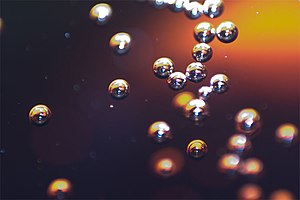Carbonated drink: Difference between revisions
a ref for respectability |
some numbers |
||
| Line 3: | Line 3: | ||
'''Carbonated drinks''' are beverages that contain dissolved [[carbon dioxide]]. The [[dissolution (chemistry)|dissolution]] of CO<sub>2</sub> in a [[liquid]], gives rise to ''fizz'' or ''effervescence''. The process usually involves carbon dioxide under high pressure. When the pressure is removed, the carbon dioxide is released from the solution as small bubbles, which causes the solution to become [[Effervescence|effervescent]], or fizzy. A common example is the dissolving of carbon dioxide in [[water]], resulting in [[carbonated water]]. Carbon dioxide is only weakly soluble in water, therefore it separates into a [[gas]] when the pressure is released. |
'''Carbonated drinks''' are beverages that contain dissolved [[carbon dioxide]]. The [[dissolution (chemistry)|dissolution]] of CO<sub>2</sub> in a [[liquid]], gives rise to ''fizz'' or ''effervescence''. The process usually involves carbon dioxide under high pressure. When the pressure is removed, the carbon dioxide is released from the solution as small bubbles, which causes the solution to become [[Effervescence|effervescent]], or fizzy. A common example is the dissolving of carbon dioxide in [[water]], resulting in [[carbonated water]]. Carbon dioxide is only weakly soluble in water, therefore it separates into a [[gas]] when the pressure is released. |
||
Carbonated beverages are prepared by mixing flavored syrup with carbonated water, both chilled.<ref>{{cite|chapter=Beverages, Nonalcoholic |
Carbonated beverages are prepared by mixing flavored syrup with carbonated water, both chilled. Carbonation levels range up to 5 volumes of CO<sub>2</sub> per liquid volume. Ginger ale, colas, and related drinks are carbonated with 3.5 volumes. Other drinks, often fruity ones, are carbonated less.<ref>{{cite|chapter=Beverages, Nonalcoholic|title=Ullmann's Encyclopedia of Industrial Chemistry|authors=Philip Crandall, Chin Shu Chen, Steven Nagy, Georges Perras, Johannes A. Buchel, William Riha |
||
|title=Ullmann's Encyclopedia of Industrial Chemistry|authors=Philip Crandall, Chin Shu Chen, Steven Nagy, Georges Perras, Johannes A. Buchel and William Riha |
|||
|year=2000|doi=10.1002/14356007.a04_035}}</ref> |
|year=2000|doi=10.1002/14356007.a04_035}}</ref> |
||
Revision as of 02:05, 24 April 2017

Carbonated drinks are beverages that contain dissolved carbon dioxide. The dissolution of CO2 in a liquid, gives rise to fizz or effervescence. The process usually involves carbon dioxide under high pressure. When the pressure is removed, the carbon dioxide is released from the solution as small bubbles, which causes the solution to become effervescent, or fizzy. A common example is the dissolving of carbon dioxide in water, resulting in carbonated water. Carbon dioxide is only weakly soluble in water, therefore it separates into a gas when the pressure is released.
Carbonated beverages are prepared by mixing flavored syrup with carbonated water, both chilled. Carbonation levels range up to 5 volumes of CO2 per liquid volume. Ginger ale, colas, and related drinks are carbonated with 3.5 volumes. Other drinks, often fruity ones, are carbonated less.[1]
See also
References
- ^ "Beverages, Nonalcoholic", Ullmann's Encyclopedia of Industrial Chemistry, 2000, doi:10.1002/14356007.a04_035
{{citation}}: Cite uses deprecated parameter|authors=(help)
